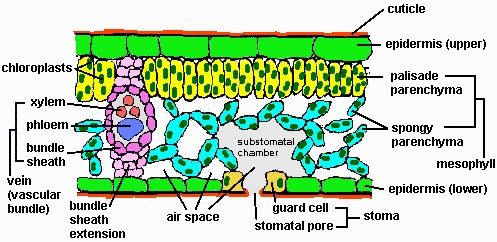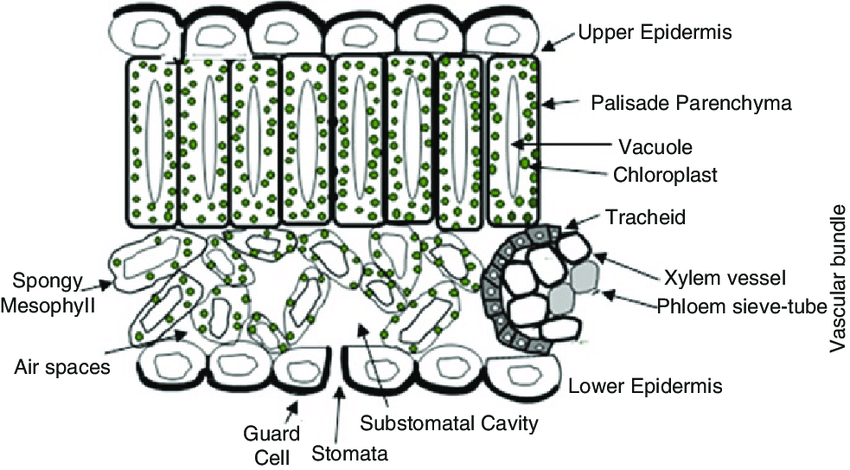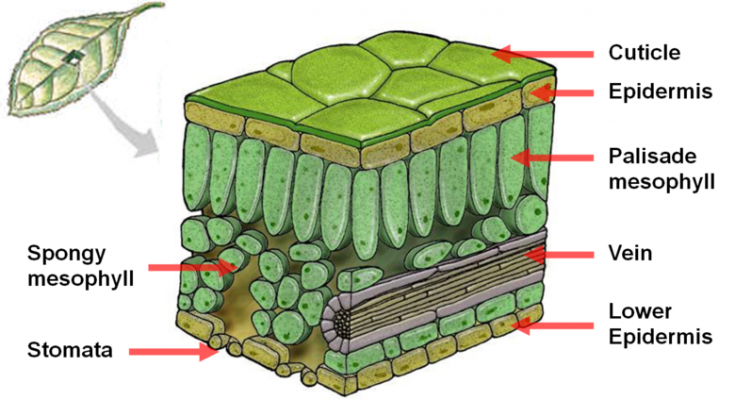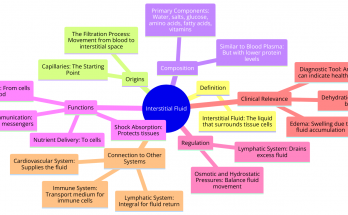Table of Contents
What is Cross Section Of The Leaf ?
Cross section of a leaf refers to a cut made perpendicular to the main axis of the leaf and revealing its internal structure.Cross-sectional view of the leaf shows its different layers which includes the upper and lower epidermis, mesophyll, veins etc. The cross section of the leaf helps to understand the distribution of chloroplasts and other cells within the leaf and how they carry out photosynthesis.

Layers of Cross Section Of Leaf
The cross-section of the leaf is arranged in layers from the top to the bottom as follows –
- Waxy Cuticle
- Chloroplasts
- Upper Epidermis
- Palisade Mesophyll
- Spongy Mesophyll
- Vascular Bundle
- Bundle Sheath Cells
- Xylem and Phloem
- Lower Epidermis
- Stomata
- Guard Cells
Leaf cross Section Diagram

Description of Cross Section Of Leaf Diagram labels
Waxy Cuticle
- The uppermost layer is called the waxy cuticle.
- The cuticle is made up of hydrocarbons and wax.
- This makes it hydrophobic, meaning that it repels water.
- Its hydrophobic nature is what causes water droplets to bead on a leaf rather than soaking in.
- It stops the plant from drying out by reducing water loss.
Also Check – What are the Adaptations of leaf for Photosynthesis
Chloroplasts
Chloroplast contains chlorophyll – a green pigment that absorbs the light energy needed for photosynthesis.
Upper Epidermis
- Just underneath the waxy cuticle is the second layer, which is called the upper epidermis. The epidermis is a transparent layer of cells around the leaf.
- The cells of the upper epidermis are very closely packed together.
- The upper epidermis has mostly protective functions.It allows as much sunlight as possible to pass through to the photosynthesizing cells.
- It also prevents water loss in conjunction with the waxy cuticle.
Palisade Mesophyll
- The third layer moving down from the top is called the Palisade Mesophyll. The palisade layer contains column-shaped cells packed tightly together.
- Each cell of Palisade Mesophyll has a nucleus and also has a very large vacuole for water storage.
- These cells are full of chloroplasts.
- This makes the third layer the palisade mesophyll the main site of photosynthesis in a leaf.
- Photons of light will shine down through the waxy cuticle and the upper epidermis, which are both mostly clear, and allow photosynthesis to take place in the chloroplast of the palisade mesophyll.
Also Check – Steps of Photosynthesis
Spongy Mesophyll
- The fourth layer from the top underneath the palisade mesophyll is called the spongy mesophyll.
- The cells of the spongy mesophyll are a little bit more irregular in shape.
- Chloroplast is present in this cell. The spongy mesophyll layer has a lot of air spaces that allow gas exchange.
Vascular Bundle
- This space usually contains water and oxygen.
- The vascular bundle is round and is responsible for moving products around the leaf.
Bundle Sheath Cells
- The outside coating of the vascular bundle is made up of a large group of closely packed cells.
- These cells are called bundle sheath cells and they keep all of the vasculature together.
Also Check – Xylem – Definition , Structure, Components (Types), Functions And Importance
Also Check – Phloem – Definition, Structure, Function, Types and How does Phloem tissue work
Xylem and Phloem
- Inside the bundle sheath cells is a tightly packed group of tubules called xylem, phloem and bundle sheath cells.
- Water and minerals are delivered to the leaf and other parts of the plant in xylem tubes.
- Glucose produced by photosynthesis is taken away in phloem tubes to the rest of the plant.
- Even though these two types of tubules are doing different things, they are right next to each other which makes for a very efficient system.
Also Check – What are the Differences between the Transport of Materials in Xylem and Phloem
Lower Epidermis
- Just underneath the vascular bundle and the spongy mesophyll is another layer of epidermis.This is called the lower epidermis because it’s on the lowest part of the leaf. Just like the upper epidermis, the lower epidermis has cells that are packed very closely together in order to prevent water loss.
- Underneath the lower epidermis there is one more waxy cuticle layer, just like on the top.
- It helps to prevent water loss.
- The lower waxy cuticle and the lower epidermis of the leaf has few vascular bundle
Stomata
- At the bottom of the leaf there are small openings for the exchange of gas called stomata.
- This opening allows for carbon dioxide gas to flow in, oxygen gas to flow out, and water vapor to flow out.
Also Check – Mechanism of opening and Closing of the Stomata
Guard Cells
- If Stomata are open all the time the leaf would rapidly dry out.
- Two guard cells surround each stoma, controlling when the stoma opens and closes.
Also Check – How do the Guard cells Regulate Opening and Closing of Stomatal Pores


One Comment on “Cross Section of Leaf Class 10”